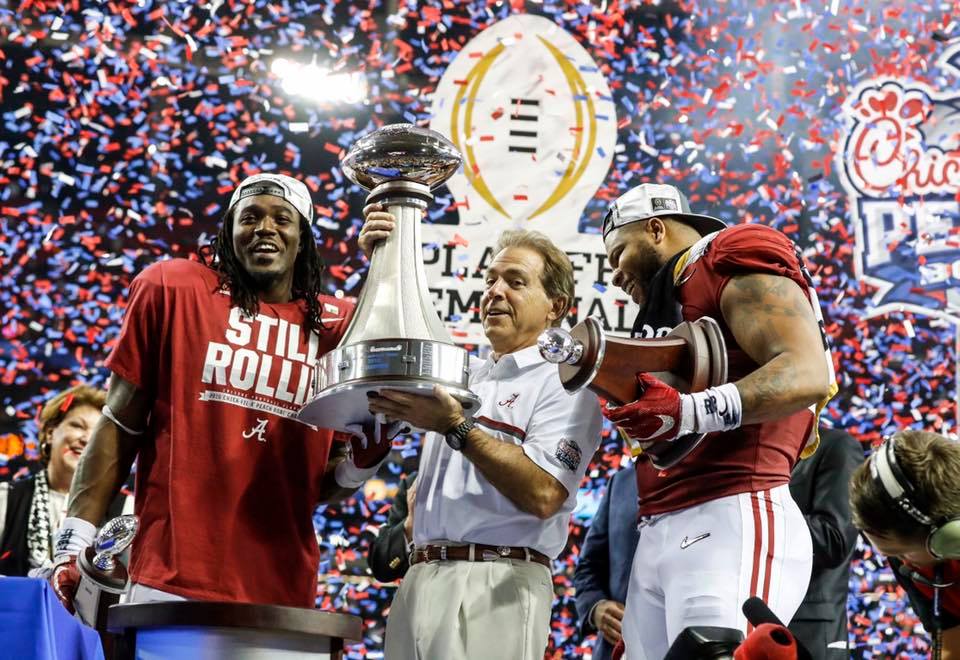
Alabama defeated Washington to advance to its second straight College Football Playoff National Championship Game. Alabama won the national title last year over Clemson and will again face the Tigers for the crown. What is remarkable about this amazing run is that way back in 2006 none of this seemed possible in the wildest imaginations of Alabama fans. In 2006, Alabama football was led by a feckless administration adrift and out-classed in the competitive SEC. Regardless of what happens in Tampa, Alabama is the colossus astride college football. It has been an incredible decade.
When I started this website in 2006, it was with the premise that improved leadership was all that was necessary to elevate Alabama football back to a top program in the SEC. The arguments ranged from the simple—that every coach post-Paul W. Bryant had won at least 10 games and a conference championship including such lowlights as Mike Dubose and that we should apply a tough standard to Mike Shula—to the more historical-philosophical military maxim “that an army of rabbits led by a lion is superior to an army of lions led by a rabbit.” That seems, in retrospect, an awful lot like Bum Phillips saying that a good coach, “Can take his’n and beat your’n and take your’n and beat his’n.”
My whole point was that play calling, offensive and defensive schemes and even conditioning programs don’t matter as much as the man in charge of all those things. You can have the best schemes and the best players, but without accountability the results won’t be great; or, at least you won’t achieve the best results possible. Alabama was a program of tremendous potential, but it had languished in what seemed like perpetual promise never delivering to its fans during the post-Bryant era. It was always next year. It was always the next big recruit who would turn things around for Alabama. Even the national championship in 1992 under Gene Stallings seemed to only tease about a renewed Alabama program.
Thankfully, Alabama Athletic Director Mal Moore and University of Alabama President Robert Witt changed all that. They picked a leader and turned the Tide.
It doesn’t mean that Saban’s way is the only way. His obsessive attention to detail is a great benefit, but it is not the only way to lead. There is always room for the great delegators and top-view CEO coaches. However, I think the key piece of the Saban process is the stability it provides; Saban doesn’t vary. As Lane Kiffin said this week during media sessions at the Chick-Fil-A Bowl in Atlanta, Saban’s approach to the game is the same every week—big game, small game, big win, small win or loss. In a contemporary world, full of uncertainties, stability and predictability might just be Saban’s greatest magic device. Plus, this has always been good advice. Napoleon wrote it in his Maxims, “The first qualification in a general-in-chief is a cool head — that is, a head which receives just impressions, and estimates things and objects at their real value. He must not allow himself to be elated by good news, or depressed by bad.”
That doesn’t mean you don’t hand out a few “ass-chewings,” because, “A good general, a well-organized system, good instructions, and severe discipline, aided by effective establishments, will always make good troops, independently of the cause for which they fight,” Napoleon wrote. Emphasis on the severe discipline part.
The proof of Alabama’s greatness can be listed in national championships under Nick Saban (four won in 2009, 2011, 2012 and 2015), SEC championships (five including three straight) and such sublime stats as 16 consecutive wins over ranked opponents and a current 26-game winning streak. Saban even defeated longtime Goliaths like Texas (2009) and Notre Dame (2012) to win these national championships. If you can name something an Alabama fan longed to witness, Nick Saban has made it happen.
That 2009 title is special to me. My mom who watched more Alabama football and loved Alabama football more than anyone in my family. She would tell stories of watching Joe Namath play in person, and how different it was to sit in the stands in the 1960s. She knew the highs of the Bryant era and the lows of the post-Bryant doldrums. She could tell stories of those losses to Texas and Notre Dame and how those haunted Alabama fans. Saban’s victory over Texas erased many of those bad memories and though she died just days before the 2011 BCS title was decided with a win over LSU, I think she found more enjoyment in Alabama football than ever before. All of that thanks to Saban.
Nick Saban proved in 2008 that Alabama made the right move and put the Crimson Tide back into the SEC and national title discussion. Of course, there were always arguments and nay-sayers ready to critique Saban, his methods and say that his time of greatness ended. Saban’s response was to persevere. He kept winning and putting great teams on the field. He adapted. He thrived. At some point, blogging seemed unnecessary. Everyone recognized Saban was the greatest coach of his generation and likely of all time. Sure, there will always be doubters and someone to declare the dynasty dead, but Saban proved the critics wrong. Every year. What more could a writer add to the statements on the field?
In the end, Saban built a dynasty (one that is still going on regardless of what happens in Tampa) in an era when hyper-competitive college football was supposed to render dynasties impossible. Saban dominated the SEC in a way that everyone was told would be impossible with all the resources and talents available in the conference. In doing so, Saban processed everyone—college football, the SEC and even bloggers who can’t even argue about how incredible Nick Saban is.
